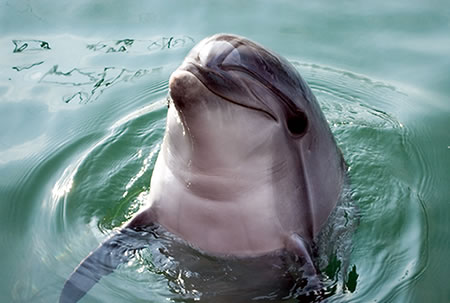Porpoises Use Sound Searchlights To Hunt

Danish researchers have worked out exactly how porpoises manage to finely adjust the beams of sound they use whilst hunting. Porpoises use buzzes and clicks when they hunt, relying on the echoes from their prey to pinpoint their location. The results of the study show that hunting porpoises switch from a narrow to a wide beam of sound as they home in on their prey, in much the same way one would adjust a flash light.
Dolphins and whales use the same technique
The researchers believe that dolphins and whales probably use the same technique to trap fish and that switching from narrow to wide beams of sound helps prevent dolphins, porpoises and whale prey from evading capture. The purpose of the study is to find a way to help stop porpoises and other toothed whales from getting trapped by fishing nets. The study was led by Danuta Wisniewska of Aarhus University and published in the journal eLife. Dr. Wisniewska and her fellow researchers worked with harbour porpoises located off the coast of Denmark. They used submersible microphones in a semi natural enclosure which measured the sounds the porpoises produced.
“The facility is quite exceptional, the animals still have access to the sea floor and are only separated from the harbour by a net. Fish are able to come in, so they’re still hunting.” explained Dr Wisniewska.
A unique environment
Making use of the unique environment, researchers were able to attach sound detecting tags to the porpoises and also place a number of microphones which picked up sounds around the porpoise enclosure. The researchers then carried out a number of experiments to calculate where the porpoises were directing the sound energy they produced. In one particular experiment, the researchers dropped fish into the enclosure as they sought to tempt the porpoises into hunting. As the echo locating porpoises begin to hunt they flip from an exploratory clicking to a high frequency buzz which is more intense. The reason for this is they are seeking to elicit a continuous echo from their prey.
“If you were trying to find your car in a car park, you could use a narrow beam over a long distance and still see a lot. But when you’re trying to get your keys into the car, you would switch to a wider beam. This is similar to what we see in porpoises.” Dr Wisniewska explained.
Helping to prevent porpoises from getting caught up in fishing nets
According to the results of the study, the porpoises that were being examined managed to broaden their sound beam by as much as 50% as they homed in on their prey. The ability to fine tune their echolocation is controlled by a fatty structure located in their forehead know as the melon and acts as a kind of “sound lens”. The harbour porpoises that participated in the research came to the study facility after being rescued from fishing nets they had been caught up in. The researchers hope their efforts will result in ways of using sound to help porpoises from accidentally chasing their prey into these nets.



